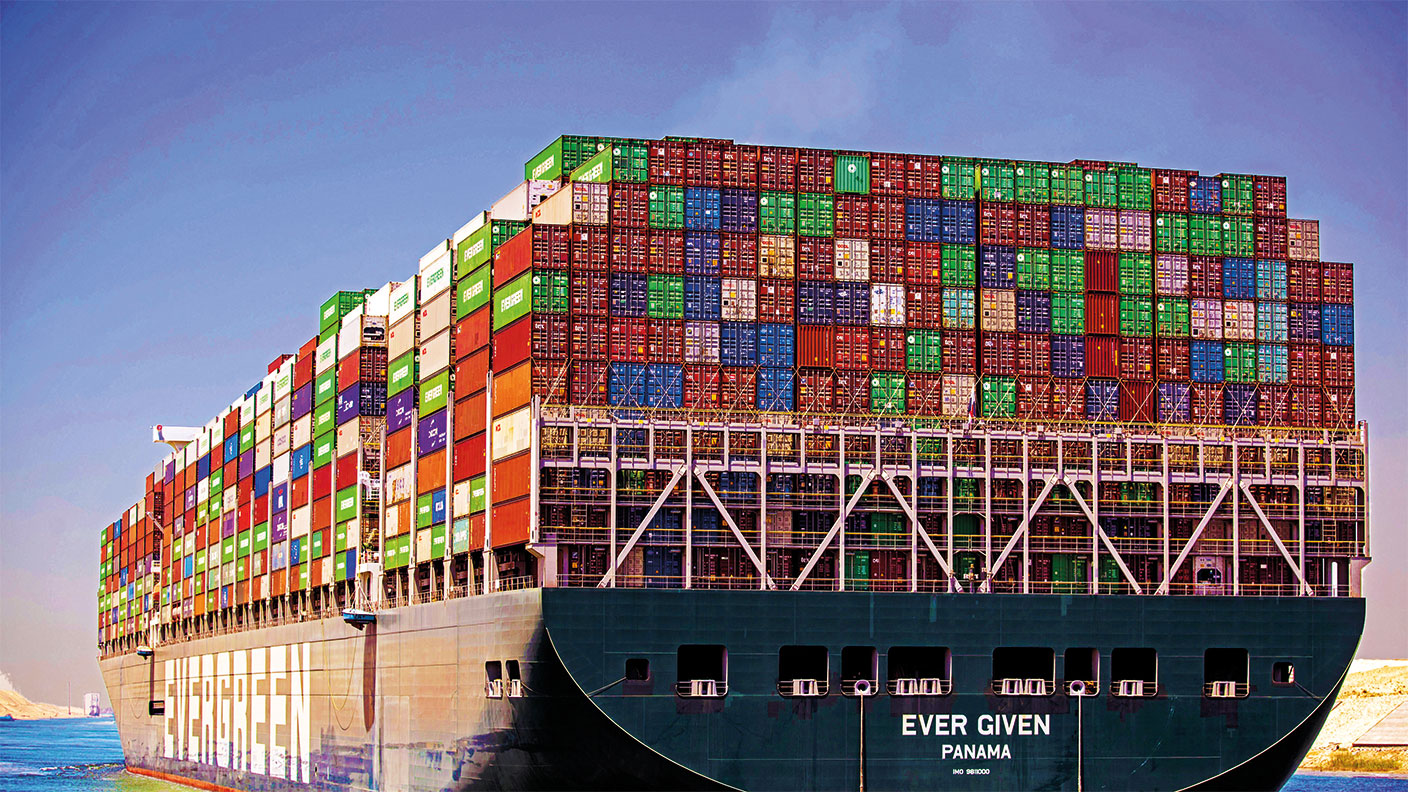How to profit from the global shipping industry
Container rates have soared, but tankers and bulk carriers are poised for recovery, says David J. Stevenson.


The global supply chain sounds like a well-oiled machine. Starting with raw-materials producers such as farmers or miners, it progresses to manufacturers, extends to logistics operations (storage, transport and distribution), then ultimately reaches retailers and end users.
When working properly, this supply chain makes the world economy go round by providing all the things we need for our daily lives. Most people aren’t aware about how complex – and potentially fragile – a supply chain can be. Things change quickly when disruption occurs, as it has in spades over the last two years. While there had always been localised hiccups, overall the system worked well until Covid-19 struck.
Whether or not the various restrictions put in place by governments did anything to stop the virus spreading (I’m not getting into that argument here), they certainly put a bag of spanners in the supply chain, with shortages of labour, lorry drivers and computer chips for cars all making the headlines. That’s resulted in surging inflation.
MoneyWeek
Subscribe to MoneyWeek today and get your first six magazine issues absolutely FREE

Sign up to Money Morning
Don't miss the latest investment and personal finances news, market analysis, plus money-saving tips with our free twice-daily newsletter
Don't miss the latest investment and personal finances news, market analysis, plus money-saving tips with our free twice-daily newsletter
Misfortune has also played a part. When the Ever Given, one of the planet’s largest container vessels, got stuck in the Suez Canal in March 2021, it delayed hundreds of ships and significantly hit global trade. “A host of disruptions to production and shipping interacted with soaring demand for goods to produce bare shelves and rising prices,” says the Economist in summary. “Although goods have been in short supply, the number of measures tracking supply-chain woes has proliferated at an impressive pace in recent months. All paint a picture of historically high levels of disruptions, and an uncertain path ahead.
Container rates are still robust
While restrictions have reduced (although not totally gone), the situation is emphatically not back to pre-pandemic norms. US logistics firm Flexport has an “ocean timeliness indicator” that indicates how long shipments have taken to travel from a supplier’s warehouse to their destination port’s departure gate on freight routes from China to both Europe and America. Three years ago these journeys took just under 60 days to Europe and just under 50 to America.
Driven by pandemic restrictions, transport times have since grown to 108 days and 114 days for Europe and America respectively, according to Flexport. We’ve all seen scenes of cargo ships queueing up to unload their payloads. In turn, this has been a recipe for soaring freight rates. But the picture for shipping costs is quite mixed.
Let’s now examine it in greater detail. The Freightos Baltic index (FBX) measures daily rates for shipping a 40-foot container (known as forty-foot equivalent units or FEUs) charged by freight forwarders for 12 main shipping routes through Asia, Europe and the Americas. Having marked time at around $1,500/FEU since its launch three years previously, the FBX took off in early 2020 and reached a mid-September 2021 peak above $11,000 (the actual numbers are less important than the scale of the increase).
The FBX currently stands at around $9,500. Even though the order book for new container ships doubled last year, deliveries have not yet been enough to make a difference, and sentiment and freight rates in this part of the shipping market remain strong.
Pessimism in the dry bulk market
However, a different tale is being told by the Baltic Dry index (BDI). This measures daily changes in the cost of transporting raw materials such as coal and steel by gauging multiple shipping rates across more than 20 routes for each of the BDI’s component vessels.
The index is composed of three sub-indices that monitor different dry bulk carriers. Capesize vessels are so big that they must transit oceans by rounding the capes of South Africa or Chile. Panamax can fit through the locks of the Panama canal and normally carry coal or grain. Smaller Supramax ships are usually used for less voluminous bulk materials and have a cargo capacity of around 50,000 to 60,000 deadweight tons (DWT). By comparison, the very largest ore carrier Capesize vessels go to 400,000 DWT, although the average capacity is closer to 150,000 DWT.
The BDI is often seen as a leading economic activity indicator, since it reflects changes in supply and demand for key manufacturing and construction materials, but it can be very volatile. From the early months of 2020 as the Covid-19 pandemic developed, the BDI rose more than ten times, broadly matching the move in the FBX. But since October 2021 it has tumbled by more than 60%. Why? Part of the story is that China capped steel production in October, and stopped over-borrowed property developers from taking out more loans, curbing demand for raw materials.
Yet it’s not that simple. “Brokers and operators are blaming the weak market on lockdowns in China, the debottlenecking of ports in China, the Indonesian coal export ban, the easing of the Indonesian export ban, the Winter Olympics, Christmas and the Western New Year holidays, a sudden surfeit of ballasters [suppliers of ballast], rains in Brazil, a lack of rain in Brazil and Argentina, and even fog in the Bosporus,” says Splash247, a maritime news website. “In other words, sentiment is almost universally negative but there is no smoking gun, no single cause that everyone can agree on for the fall in the market.”
At least on the face of it, “the fundamentals of supply and demand remain in owners’ favour”. Last year, the fleet grew by just 4%, which “was hardly enough to cause this market meltdown on the back of such strong demand growth in 2021”. In short, there’s a lot of pessimism in the dry bulk market, even though fleet growth is set to slow to below 2% this year and next. Thus dry bulk has “the best supply-demand picture” of any shipping segment in 2022, says Randy Giveans of investment bank Jefferies on FreightWaves. “It’s hard to see a situation where demand doesn’t outpace supply.
Tankers are coming off a low base
The third major part of the shipping sector looks interesting as well. Freight rates in the tanker market also soared in early 2020 as Covid-19 kicked in, then dropped back, but are now picking up steam again. “Do I think tanker rates are going to be incredible [in 2022]?” says Giveans. “No. Will they be much better than in 2021? Of course. This has been literally the worst year in decades. I’m still conservative relative to most people out there, but it’s about the rate of change. We’re on our way to a recovery.” Granted, growth in the “dirty” tanker fleet could top 5% in 2022, says Braemar Research (dirty tankers carry crude, clean ones carry refined fuels).
But then there’s the unpredictable impact of shocks to the oil market. As Russia invaded Ukraine, the Baltic Dirty Tanker index rose from around 700 to around 1,500 (these are standardised units rather than monetary amounts). It has since fallen back to around 1,100, but that’s still as high as it’s been since April 2020. The gain was mostly due to higher rates for mid-sized Aframax tankers that ply the areas directly affected by geopolitical tensions (the Black Sea, the Mediterranean and the Baltic Sea).
Demand for Suezmax tankers (able to transit the Suez canal) have risen less, while rates for the self-explanatory very large crude carriers (VLCCs) that serve long-haul routes remain depressed. If global oil supply remains tight, extra demand for non-Russian crude due to sanctions could drive the cost of chartering tankers higher.
Get the latest financial news, insights and expert analysis from our award-winning MoneyWeek team, to help you understand what really matters when it comes to your finances.

David Stevenson has been writing the Financial Times Adventurous Investor column for nearly 15 years and is also a regular columnist for Citywire.
He writes his own widely read Adventurous Investor SubStack newsletter at davidstevenson.substack.com
David has also had a successful career as a media entrepreneur setting up the big European fintech news and event outfit www.altfi.com as well as www.etfstream.com in the asset management space.
Before that, he was a founding partner in the Rocket Science Group, a successful corporate comms business.
David has also written a number of books on investing, funds, ETFs, and stock picking and is currently a non-executive director on a number of stockmarket-listed funds including Gresham House Energy Storage and the Aurora Investment Trust.
In what remains of his spare time he is a presiding justice on the Southampton magistrates bench.
-
 Boost for over 100,000 families on Child Benefit as new HMRC payment system rolled out
Boost for over 100,000 families on Child Benefit as new HMRC payment system rolled outThousands of households will no longer have to pay the dreaded High Income Child Benefit Charge through self-assessment
-
 Are you being haunted by the ghost of Christmas past? How festive cutbacks could boost your long-term wealth
Are you being haunted by the ghost of Christmas past? How festive cutbacks could boost your long-term wealthThe average family spends around £1,000 over the Christmas season. Here’s how much you could have gained if you had invested some of the money instead.
-
 The steady rise of stablecoins
The steady rise of stablecoinsInnovations in cryptocurrency have created stablecoins, a new form of money. Trump is an enthusiastic supporter, but its benefits are not yet clear
-
 Goodwin: A superlative British manufacturer to buy now
Goodwin: A superlative British manufacturer to buy nowVeteran engineering group Goodwin has created a new profit engine. But following its tremendous run, can investors still afford the shares?
-
 A change in leadership: Is US stock market exceptionalism over?
A change in leadership: Is US stock market exceptionalism over?US stocks trailed the rest of the world in 2025. Is this a sign that a long-overdue shift is underway?
-
 Modern Monetary Theory and the return of magical thinking
Modern Monetary Theory and the return of magical thinkingThe Modern Monetary Theory is back in fashion again. How worried should we be?
-
 Metals and AI power emerging markets
Metals and AI power emerging marketsThis year’s big emerging market winners have tended to offer exposure to one of 2025’s two winning trends – AI-focused tech and the global metals rally
-
 King Copper’s reign will continue – here's why
King Copper’s reign will continue – here's whyFor all the talk of copper shortage, the metal is actually in surplus globally this year and should be next year, too
-
 The coming collapse in the jobs market
The coming collapse in the jobs marketOpinion Once the Employment Bill becomes law, expect a full-scale collapse in hiring, says Matthew Lynn
-
 Renewable energy funds are stuck between a ROC and a hard place
Renewable energy funds are stuck between a ROC and a hard placeRenewable energy funds were hit hard by the government’s subsidy changes, but they have only themselves to blame for their failure to build trust with investors